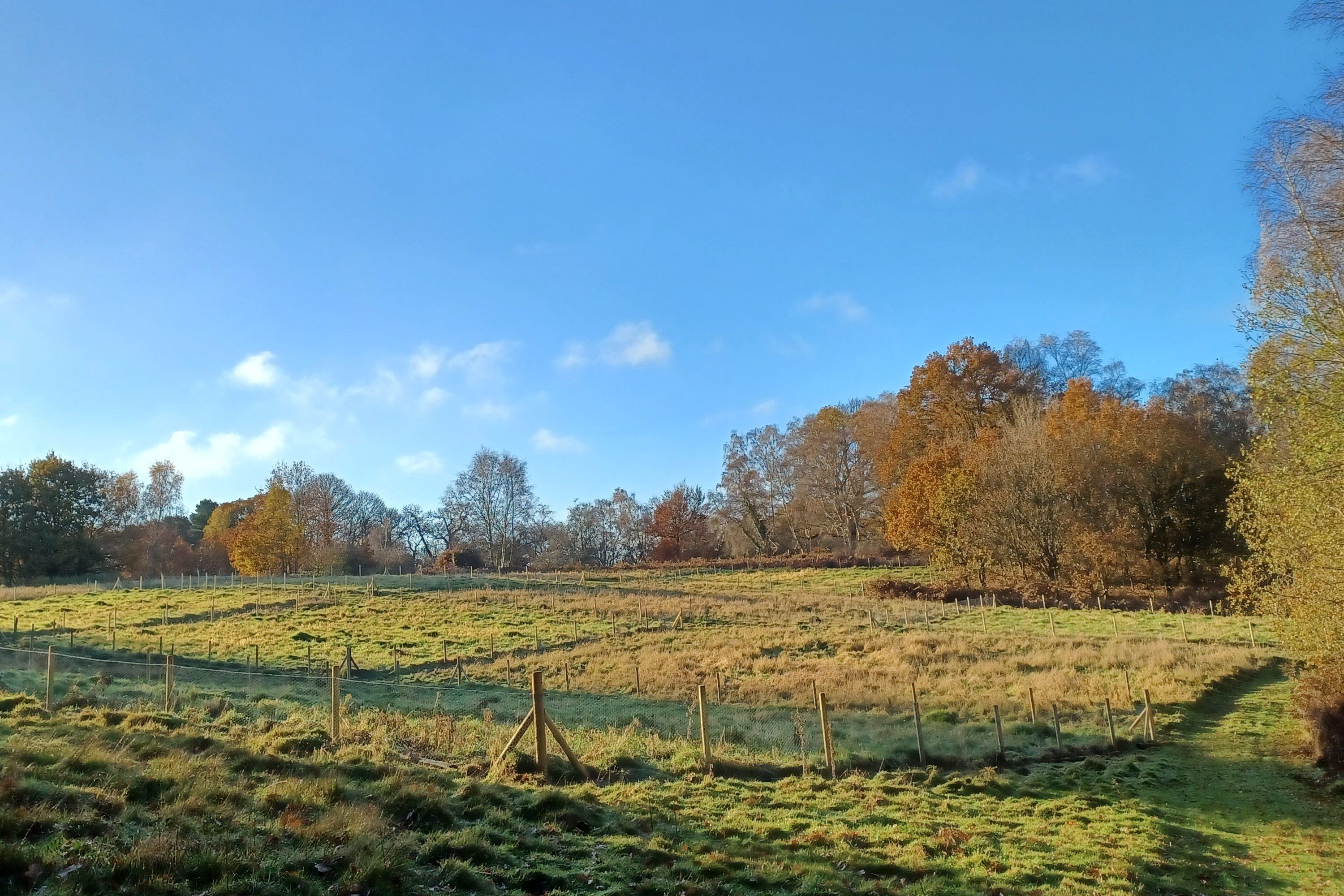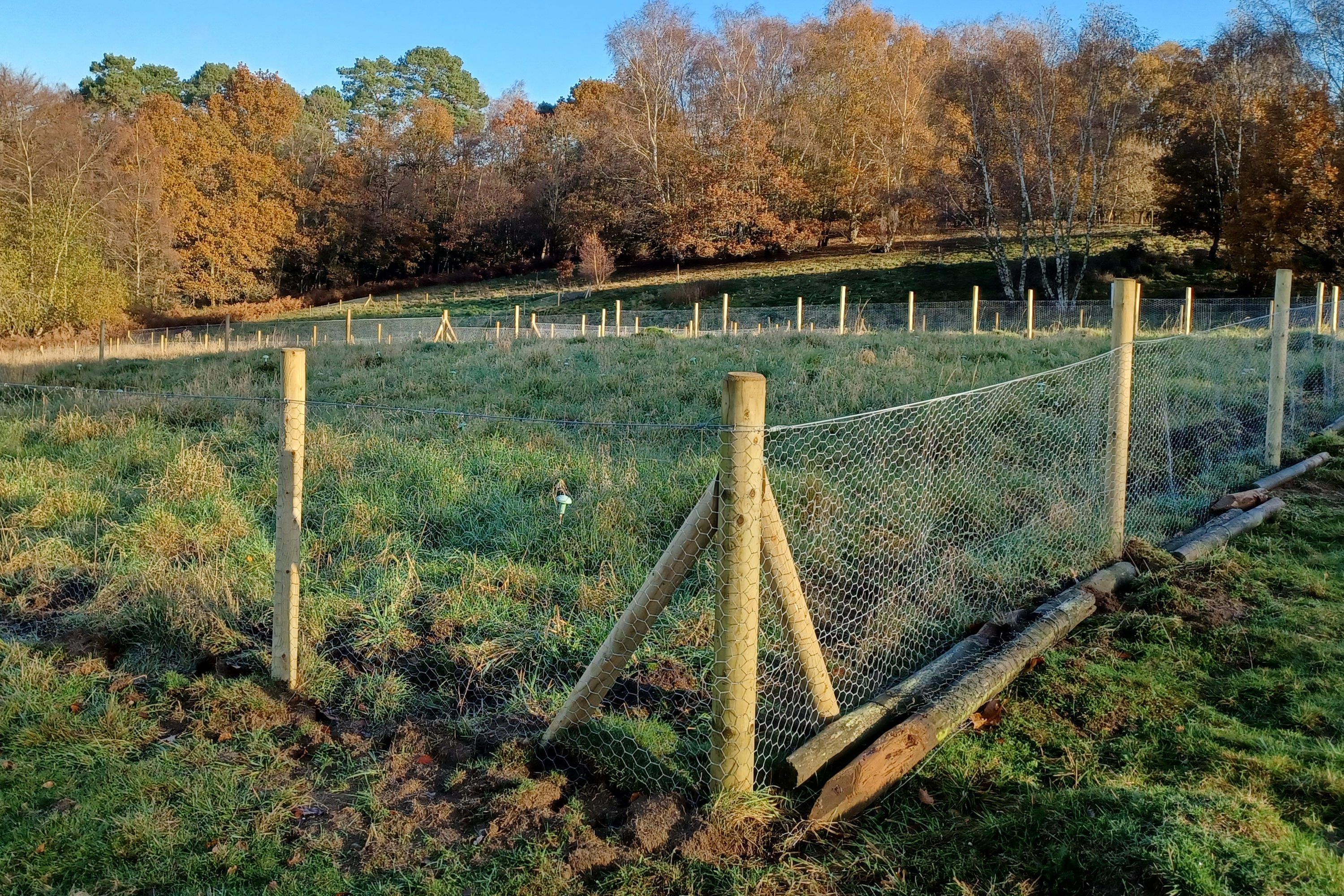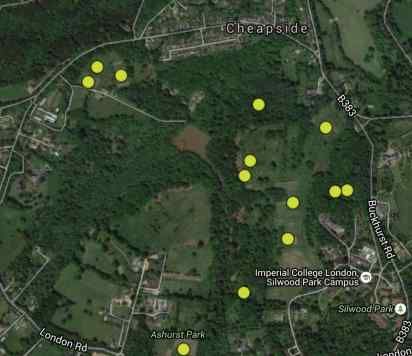For over 30 years a section of grassland at Silwood Park has been manipulated to understand the degree to which the availability of nutrients and herbivory influence plant species composition and productivity and how their effects impact other organisms and ecosystem functions. The Nash' Field experiment (plots K-S) was established in 1991 with similar treatments to the Park Grass Experiment hosted by Rothamsted Research at Harpenden Hertforshire, United Kingdom, since 1856. The study site is located in a meadow with sandy, acidic soil of the Bagshot Series where introduced European rabbits (Oryctolagus cuniculus) have been particularly abundant since the 1950s. From 1947 to 1991 Nash's field was managed as a hay meadow dominated by Agrotis capillaris, Fetusca rubra, Holcus lanatus, Galium saxalite and Rumex acetosella. The field is currently surrounded by an Oak (Quercus robur), Sycamore (Acer pseudoplatanus) and Silver Birch (Betula pendula) woodland and a Bracken (Pteridium aquilinum) stand.
The overall objective of the Nash' Field experiment is to assess the effect of fertilizer nutrients and herbivore removal on grassland diversity and biomass. It is a six-factor factorial experiment replicated in two blocks of 22 x 44 m plots using a split-plot design. The experimental plot units (1152 2 x 2 m plots) receive a combination of treatments that include application of four nutrients in different combinations (N, K, P, Mg), the exclusion of vertebrate (rabbits) and invertebrate (insects and molluscs) herbivores, the manipulation of soil pH through periodic applications of lime, and the application of selective herbicides.
Data of aboveground biomass or coverage per plant species of all herbaceous plants present has been collected annually for several years since 1992. More recently, the experiment has been used to study the effect that fertilization and herbivory has on soil microbial diversity and ecosystem functions.
Nash's field is one of the experiments of the Georgina Mace Centre for the Living Planet and is part of The Ecological Continuity Trust (ECT) and the European Join Program on Agricultural Soil (EPJ soil). Since its creation in 1991 by Professor Mick Crawley, this project has been supported by the Department of Life Sciences at Imperial College London and more recently by NERC grants to Professor Thomas Bell. In 2023 a generous maintenance grant from ECT supported the replacement of fences in the experiment.
Nash's k-s google map
Detail information Nash's plots K-S
Publications
Edwards GR, Crawley MJ (1999) Herbivores, seed banks and seedling recruitment in mesic grassland. Journal of Ecology, 87: 423–435.
Edwards GR, Crawley MJ, Heard MS (1999) Factors influencing molehill distribution in grassland: Implications for controlling the damage caused by molehills. Journal of Applied Ecology, 36: 434–442.
Edwards GR, Bourdôt GW, Crawley MJ (2000) Influence of herbivory, competition and soil fertility on the abundance of Cirsium arvense in acid grassland. Journal of Applied Ecology, 37: 321–334.
Rees M, Condit R, Crawley M, Pacala S, Tilman D (2001) Long-term studies of vegetation dynamics. Science, 293: 650–655.
Crawley MJ (2005) Silwood Park and its history. In: Crawley MJ, ed. The Flora of Berkshire. Harpenden, Hertfordshire, UK: Brambleby Books, 215–253.
Del-Val E, Crawley MJ (2005) What limits herb biomass in grasslands: competition or herbivory? Oecologia, 142: 202–211.
Allan E, Crawley MJ (2011) Contrasting effects of insect and molluscan herbivores on plant diversity in a long-term field experiment. Ecology Letters, 14: 1246–1253.
Fornara DA, Banin L, Crawley MJ (2013) Multi-nutrient vs. nitrogen-only effects on carbon sequestration in grassland soils. Global Change Biology, 19: 3848–3857.
Macdonald CA, Crawley MJ, Wright DJ, Kuczynski J, Robinson L, Knight R, Al-Soud WA, Sørensen SJ, Deng Y, Zhou J, Singh B (2015) Identifying qualitative effects of different grazing types on below-ground communities and function in a long-term field experiment. Environmental Microbiology, 17: 841–854.
Cenini VL, Fornara DA, McMullan G, Ternan N, Lajtha K, Crawley, MJ (2015) Chronic nitrogen fertilization and carbon sequestration in grassland soils: evidence of a microbial enzyme link. Biogeochemistry, 126: 301
Cenini VL, Fornara DA, McMullan G, Ternan N, Carolan R, Crawley MJ, Clement J-C, Lavorel S (2016) Linkages between extracellular enzyme activities and the carbon and nitrogen content of grassland soils. Soil Biology and Biochemistry, 96: 198-206.
Heyburn J, McKenzie P, Crawley MJ, Fornara DA (2017) Long-term belowground effects of grassland management: the key role of liming. Ecological Applications, 27: 2001-2012.
Heyburn J, Mckenzie P, Crawley MJ, Fornara DA (2017) Effects of grassland management on plant C:N:P stoichiometry: implications for soil element cycling and storage. Ecosphere, 8(10) e01963
Egan G, Crawley MJ, Fornara DA (2018) Effects of long-term grassland management on the carbon and nitrogen pools of different soil aggregate fractions. Science of the Total Environment, 613: 810-819.
Egan G, Zhou X, Wang D, Jia Z, Crawley MJ, Fornara D (2018) Long-term effects of grassland management on soil microbial abundance: implications for soil carbon and nitrogen storage. Biochemistry, 141: 213-228.
Guignard MS, Crawley MJ, Kovalenko D, Nichols RA, Trimmer M, Leitch AR, Leitch IJ (2019) Interactions between plant genome size, nutrients and herbivory by rabbits, molluscs and insects on a temperate grassland. Proceedings of the Royal Society b-Biological Sciences, 286.
Leverkus AB, Crawley MJ (2020) Temporal variation in effect sizes in a long‐term, split‐plot field experiment. Ecology, 101(6): e03009
Thornley R, Gerard FF, White K, Verhoef A (2022) Intra-annual taxonomic and phenological drivers of spectral variance in grasslands. Remote Sensing of Environment, 271.
Mombrikotb SB, Agtmaal MV, Johnstone E, Crawley MJ, Gweon HS, Griffiths RI, Bell T (2022) The interactions and hierarchical effects of long-term agricultural stressors on soil bacterial communities. Environmental Microbiology Reports, 14: 711-18
Smith TP, Mombrikotb SB, Ransome E, Kontopoulos DG, Pawar S, Bell T (2022) Latent functional diversity may accelerate microbial community responses to temperature fluctuations. eLife, 11: e80867
Data
Data from this field study is open access and can be accessed in Zenodo DOI: 10.5281/zenodo.13345224
Find descriptions of data available also in data summary, and metadata files (PDF).
Data has been collected annually in June-July in all or a subset of experimental plot units (2 x 2 m). Two types of data have been collected in Nash's Field: aboveground biomass (years 1992-2000, 2004, 2006, 2013) and percentage cover (years 2000, 2001, 2004-2006, 2008, 2012, 2019, 2023) of each species of herbaceous plant present in a sampled plot. A change in the type of data collected from biomass to percentage of cover was necessary to adapt to the resources available for running the experiment. Both types of data were collected in 2000, 2004 and 2006 to aid in the comparison of results. A complete set of data (1,152 2 x 2 m plot units) is available for 1997 (biomass), 2000 (biomass and cover), 2005, 2006 and 2019 (cover). Data from a subset of plots were surveyed in all other years.
Experimental design
Nash' Field experiment is a six-factor factorial experiment replicated in two blocks of 22 x 44 m plots using a split-plot design. It contains 8 invertebrate exclusion plots (22 x 44 m), 16 vertebrate exclusion plots (22 x 22 m), 32 soil pH plots (8 x 18 m), 96 plant competition plots (6 x 8 m) and 1152 fertilization plots (2 x 2 m).
Factor 1 - Drainage: There are two blocks of four plots, each measuring 22 x 44 m. Four plots (S, L, M, N) separated at least 10 m from each other are set in presumably moister soil (upslope) and four plots (P, Q, R, K) in a dryer area (downslope).
Factor 2 - Invertebrate herbivore exclusion: Each of the four 22 x 44 m plots in each drainage block plots is assigned a with and without insecticide, and with and without molluscicide treatment. These pesticides are applied three times a year during the growing season.
| Treatment | Plot name | Block |
|---|---|---|
| Insecticide | M | upslope |
| Insecticide | Q | downslope |
| Molluscicide | N | upslope |
| Molluscicide | P | downslope |
| Insecticide and molluscicide | S | upslope |
| Insecticide and molluscicide | R | downslope |
| No pesticide | L | upslope |
| No pesticide | K | downslope |
Factor 3 - Rabbit exclusion: Half of each 22 x 44 m plot is enclosed with a fence that excludes rabbits but not other vertebrate herbivores like voles, wood mice or deer. Fenced squares are cut for hay in late August each year, and cut herbage is raked and removed from the plots. Tree saplings are also removed from unfenced plots.
Factor 4 - Soil pH: Each fenced and unfenced plot (22 x 22 m) is divided into two 8 x 18 m subplots, separated by 2 m, to create limed and unlimed treatments. Lime in Nash's Field has decreased soil acidity from 4.1 to 7. Plots where lime are applied are indicated in the field with a row of 9 iron rods painted white and located in the southwest corner of each 2 x 2 m nutrient plot. Unlimed plots' rods are unpainted.
Factor 5 - Plant competition: Between 1992 to 1994, each 8 x 18 m subplot for both limed and unlimed treatments was subdivided into three 6 x 8 m plots to create three treatments: minus grass, minus herbs and control. The exclusion of herbs and grass was done with selective herbicides.
Factor 6 - Mineral fertilization: Each of the 6 x 8 m plant competition plots is split into 12 2 x 2 m subplots for the application of different combination of minerals: N, P, K and Mg. The fertilizers applied are
- N: Ammonium nitrate - 144 kg ha-1
- K: Muriate of potash - 224 kg ha-1
- P: Triple superphosphate - 35 kg ha-1
- Mg: Epsom salts - 11 kg ha-1
A coloured iron rod on the northwest corner of each 2 x 2 m plot indicates the nutrient treatment received. Minerals have been applied annually during the first week of April since 1992. Content of soil minerals in Nash's field made in 1991 registered 5.6 ± 0.47 mg kg-1 NaHCO3-soluble P (1 SE, n = 8), 88.4 ± 7.0 mg kg-1 exchangeable K (1 SE, n = 8), and 37.5 ± 21 (1 SE, n = 8) mg kg-1 Mg. Modeled total atmospheric N deposition estimated are to be 22 kg N ha-1yr-1
| Treatment | Minerals applied | Rod colour code |
|---|---|---|
| No nutrients | none | white |
| Plus K | K | green |
| Plus Mg | Mg | yellow |
| Plus N | N | Red |
| Plus P | P | blue |
| Plus P, K | P, K | blue & green |
| Minus P, K | N, Mg | blue, green & white |
| Minus K | N, Mg, P | green & white |
| Minus Mg | N, P, K | yellow & white |
| Minus P | N, K, Mg | blue & white |
| Minus N | K, Mg, P | red & white |
| All nutrients | N, Mg, P, K | unpainted |
Key findings
Key Findings
Watch in YouTube the ECT webinar by Mick Crawley “The Silwood Park Long-term Ecological Field Experiments” (15 July 2022)
Rabbit herbivory is the primary factor determining plant community structure in Nash's Field grassland. Invertebrate herbivores have lesser impact but their effects are substantial enough to change the biomass of individual species and thus modify the structure of the community (Del-Val & Crawley 2005). Exclusion of insects cause an increase in the dominance of grass species which in turn results in higher productivity but a loss of plant diversity. In contrast, the exclusion of molluscs, which feed selectively on seedlings of herbs, increase plant species richness but have no effect on biomass (Crawley 2005, Allan & Crawley 2011). Changes in plant community due to exclusion of invertebrate herbivores became apparent only after 8 years of the experiment (Allan & Crawley 2011).
An analysis of the first two decades of grassland manipulation in Nash’s field experiment revealed long-lasting effects in plant richness and abundance of dominant species from short-term manipulations and extreme weather events, in addition to fast responses to treatments previously reported. More importantly, as one of the largest community-level effects took more than a decade to appear, the results clearly show the importance of long-term and multifactor studies to explore ecological interactions and to understand the dynamics and resilient of ecosystems (Leverkus & Crawley 2020).
Exclusion of herbivores, particularly invertebrates, significantly decreases soil microbial biomass, community structure and abundance of microbial genes associated with biogeochemical cycles. These impacts appear to be driven by both the direct alteration of nutrient input into the soil and the indirect effect through changes in the plant community (Macdonald et al. 2015).
Fertilization with a combination of nitrogen and phosphorous, both limiting nutrients in the soil of Nash' Field, results in an increase of plant biomass and a substantial reduction in plant species richness (Crawley 2005). The addition of nitrogen also increases soil carbon sequestration when applied alone but not if combined with potassium, Magnesium and phosphorous. This effect is independent of soil pH or the composition of the plant community (Fornara et al. 2013).
Earthworm abundance decreases in herb-rich meadows with a more acidic soil and a decrease in earthworm abundance is correlated with the density of molehills in the area (Edwards et al. 1999).


